Mental Health and Safety Assessment Methods of Bus Drivers
Abstract
:1. Introduction
2. Current Status at Home and Abroad
3. Research Methods
- (1)
- Randomly select a certain sample of bus drivers.
- (2)
- Use the demographic questionnaire, SCL-90 scale, and Y-G personality scale to measure the sample drivers. Obtain basic data and perform data processing to initially analyze the factors that may affect traffic accidents.
- (3)
- Use binary logistic regression to analyze the risk factors of bus drivers’ accidents and use the risk factors as the node variables of the Bayesian network analysis model of traffic accidents.
- (4)
- Use k-means cluster analysis to discretize data and assign values to node variables. Combine expert knowledge and experience with the k2 algorithm to construct the Bayesian network structure.
- (5)
- Use the EM algorithm to learn the parameters of the Bayesian network structure.
- (6)
- Establish a Bayesian network model for evaluating bus drivers’ mental health and traffic safety, and then use Netica software to perform inference analysis on the model.
- (7)
- Use the ROC curve to evaluate the effectiveness of the model.
4. Identification of Risk Factors for Bus Drivers Prone to Accidents
4.1. Data Source
4.2. Socio-Demographic Characteristics Analysis
4.3. Characteristic Analysis of the Y-G Scale
4.4. Analysis of Psychological Characteristics of the SCL-90 Scale
4.5. Binary Logistic Regression Analysis
5. Construction of the Bayesian Network Model
5.1. Basic Principles
5.2. Node Determination
5.3. Structural Learning
5.4. Parameter Learning
6. Analysis of the Bayesian Network Model
6.1. Sensitivity Analysis
6.2. Model Reasoning
6.2.1. Accident Prediction
6.2.2. Diagnosis of Accident Causes
6.3. Model Evaluation
7. Discussion and Conclusions
Author Contributions
Funding
Data Availability Statement
Acknowledgments
Conflicts of Interest
References
- Parker, D.; Reason, J.T.; Manstead, A.; Stradling, S.G. Driving errors, driving violations and accident involvement. Ergonomics 1995, 38, 1036–1048. [Google Scholar] [CrossRef] [PubMed]
- National Bureau of Statistics of the PRC. Available online: https://data.stats.gov.cn/easyquery.htm?cn=C01&zb=A0B07&sj=2020 (accessed on 16 May 2020).
- Preti, A.; Carta, M.G.; Petretto, D.R. Factor structure models of the SCL-90-R: Replicability across community samples of adolescents. Psychiatry Res. 2018, 272, 491–498. [Google Scholar] [CrossRef]
- Hubicka, B.; Källmén, H.; Hiltunen, A.; Bergman, H. Personality traits and mental health of severe drunk drivers in Sweden. Soc. Psychiatry Psychiatr. Epidemiol. 2009, 45, 723–731. [Google Scholar] [CrossRef]
- Alavi, S.S.; Mohammadi, M.R.; Souri, H.; Kalhori, S.M.; Jannatifard, F.; Sepahbodi, G. Personality, Driving Behavior and Mental Disorders Factors as Predictors of Road Traffic Accidents Based on Logistic Regression. Iran. J. Med. Sci. 2017, 42, 24–31. [Google Scholar]
- Alavi, S.S.; Mohammadi, M.R.; Soori, H.; Ghanizadeh, M. The Cognitive and Psychological Factors (Personality, Driving Behavior, and Mental Illnesses) As Predictors in Traffic Violations. Iran. J. Psychiatry 2017, 12, 78–86. [Google Scholar]
- Tao, D.; Zhang, R.; Qu, X. The role of personality traits and driving experience in self-reported risky driving behaviors and accident risk among Chinese drivers. Accid. Anal. Prev. 2017, 99, 228–235. [Google Scholar] [CrossRef]
- Segerstrom, S.C.; O’Connor, D.B. Stress, health and illness: Four challenges for the future. Psychol. Health 2012, 27, 128–140. [Google Scholar] [CrossRef]
- Wu, W.T.; Tsai, S.S.; Wang, C.C.; Lin, Y.J.; Wu, T.N.; Shih, T.S.; Liou, S.H. Professional Driver’s Job Stress and 8-year Risk of Cardiovascular Disease: The Taiwan Bus Driver Cohort Study. Epidemiology 2019, 30 (Suppl. S1), S39–S47. [Google Scholar] [CrossRef]
- Montoro, L.; Useche, S.; Alonso, F.; Cendales, B. Work Environment, Stress, and Driving Anger: A Structural Equation Model for Predicting Traffic Sanctions of Public Transport Drivers. Int. J. Environ. Res. Public Health 2018, 15, 497. [Google Scholar] [CrossRef] [Green Version]
- Silva, D.; Cunha, L.; Barros, C.; Baylina, P. Preparing the Future Scenario of Automated Vehicles: Recommendations Drawn from the Analysis of the Work Activity of Road Transport Workers. In International Conference on Healthcare Ergonomics and Patient Safety; Springer: Cham, Switzerland, 2019. [Google Scholar]
- Tu, Z.; He, J.; Zhou, N.; Shen, X. Driver-passenger communicative stress and psychological distress among Chinese bus drivers: The mediating effect of job burnout. BMC Public Health 2021, 21, 547. [Google Scholar] [CrossRef]
- Wang, X.; Huang, K.; Yang, L. Effects of socio-demographic, personality and mental health factors on traffic violations in Chinese bus drivers. Psychol. Health Med. 2019, 24, 890–900. [Google Scholar] [CrossRef] [PubMed]
- Chalmers, T.; Maharaj, S.; Lal, S. Associations Between Workplace Factors and Depression and Anxiety in Australian Heavy Vehicle Truck Drivers. Ann. Work Expo. Health 2021, 65, 581–590. [Google Scholar] [CrossRef] [PubMed]
- Delhomme, P.; Gheorghiu, A. Perceived stress, mental health, organizational factors, and self-reported risky driving behaviors among truck drivers circulating in France. J. Saf. Res. 2021, 79, 341–351. [Google Scholar] [CrossRef] [PubMed]
- Huang, Y.-W.; Lin, P.-C.; Wang, J. The influence of bus and taxi drivers’ public self-consciousness and social anxiety on aberrant driving behaviors. Accid. Anal. Prev. 2018, 117, 145–153. [Google Scholar] [CrossRef]
- Lambert-Bélanger, A.; Dubois, S.; Weaver, B.; Mullen, N.; Bédard, M. Aggressive driving behaviour in young drivers (aged 16 through 25) involved in fatal crashes. J. Saf. Res. 2012, 43, 333–338. [Google Scholar] [CrossRef]
- Smorti, M.; Guarnieri, S. Do aggressive driving and negative emotional driving mediate the link between impulsiveness and risky driving among young Italian drivers? J. Soc. Psychol. 2016, 156, 669–673. [Google Scholar] [CrossRef]
- Kovaceva, J.; Isaksson-Hellman, I.; Murgovski, N. Identification of aggressive driving from naturalistic data in car-following situations. J. Saf. Res. 2020, 73, 225–234. [Google Scholar] [CrossRef]
- Wang, X.; Jiao, Y.; Huo, J.; Li, R.; Zhou, C.; Pan, H.; Chai, C. Analysis of safety climate and individual factors affecting bus drivers’ crash involvement using a two-level logit model. Accid. Anal. Prev. 2021, 154, 106087. [Google Scholar] [CrossRef]
- Guo, M.; Wei, W.; Liao, G.; Chu, F. The impact of personality on driving safety among Chinese high-speed railway drivers. Accid. Anal. Prev. 2016, 92, 9–14. [Google Scholar] [CrossRef]
- Wang, X.; Wang, K.; Huang, K.; Wu, X.; Huang, W.; Yang, L. The association between demographic characteristics, personality, and mental health of bus drivers in China: A structural equation model. Physiol. Behav. 2020, 229, 113247. [Google Scholar] [CrossRef]
- Xin, Z.; Long, Y.W. A bayesian network approach to causation analysis of road accidents using netica. J. Adv. Transp. 2017, 2017, 2525481. [Google Scholar] [CrossRef] [Green Version]
- Kourou, K.; Exarchos, K.P.; Papaloukas, C.; Fotiadis, D.I. A Bayesian Network-based approach for discovering oral cancer candidate biomarkers. In Proceedings of the 2015 37th Annual International Conference of the IEEE Engineering in Medicine and Biology Society (EMBC), Milan, Italy, 25–29 August 2015; pp. 7663–7666. [Google Scholar] [CrossRef]
- Zhiteneva, V.; Carvajal, G.; Shehata, O.; Hübner, U.; Drewes, J.E. Quantitative microbial risk assessment of a non-membrane based indirect potable water reuse system using Bayesian networks. Sci. Total Environ. 2021, 780, 146462. [Google Scholar] [CrossRef] [PubMed]
- Zhang, G.; Yau, K.K.; Chen, G. Risk factors associated with traffic violations and accident severity in China. Accid. Anal. Prev. 2013, 59, 18–25. [Google Scholar] [CrossRef] [PubMed]
- Fuster-Parra, P.; Vidal-Conti, J.; Borràs, P.; Palou, P. Bayesian networks to identify statistical dependencies. A case study of Spanish university students’ habits. Inform. Health Soc. Care 2016, 42, 166–179. [Google Scholar] [CrossRef] [PubMed]
- Zhang, Y.; Weng, W. A Bayesian Network Model for Seismic Risk Analysis. Risk Anal. 2021, 41, 1809–1822. [Google Scholar] [CrossRef]
- Ma, H.; Bandos, A.I.; Rockette, H.E.; Gur, D. On use of partial area under the ROC curve for evaluation of diagnostic performance. Stat. Med. 2013, 32, 3449–3458. [Google Scholar] [CrossRef]
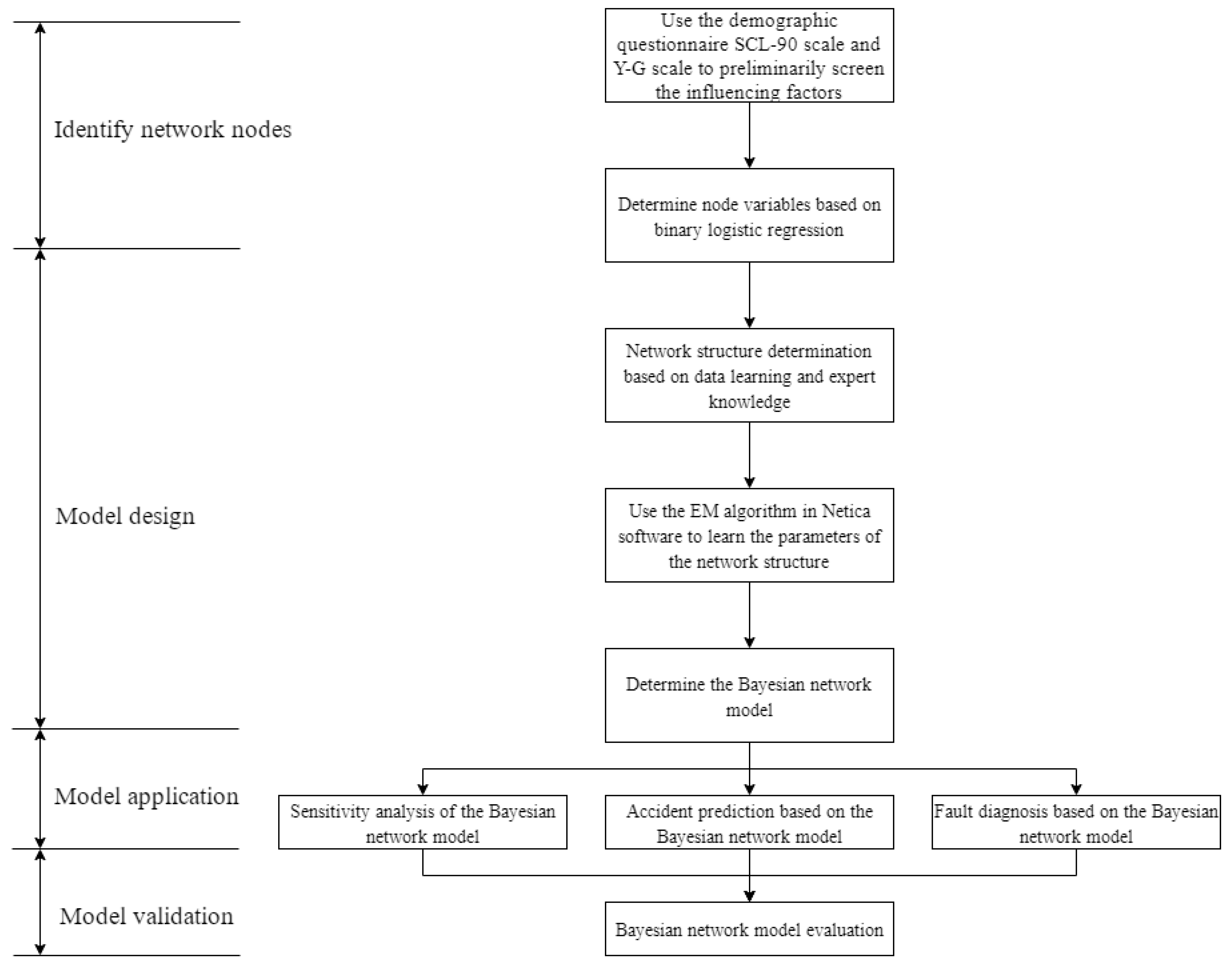
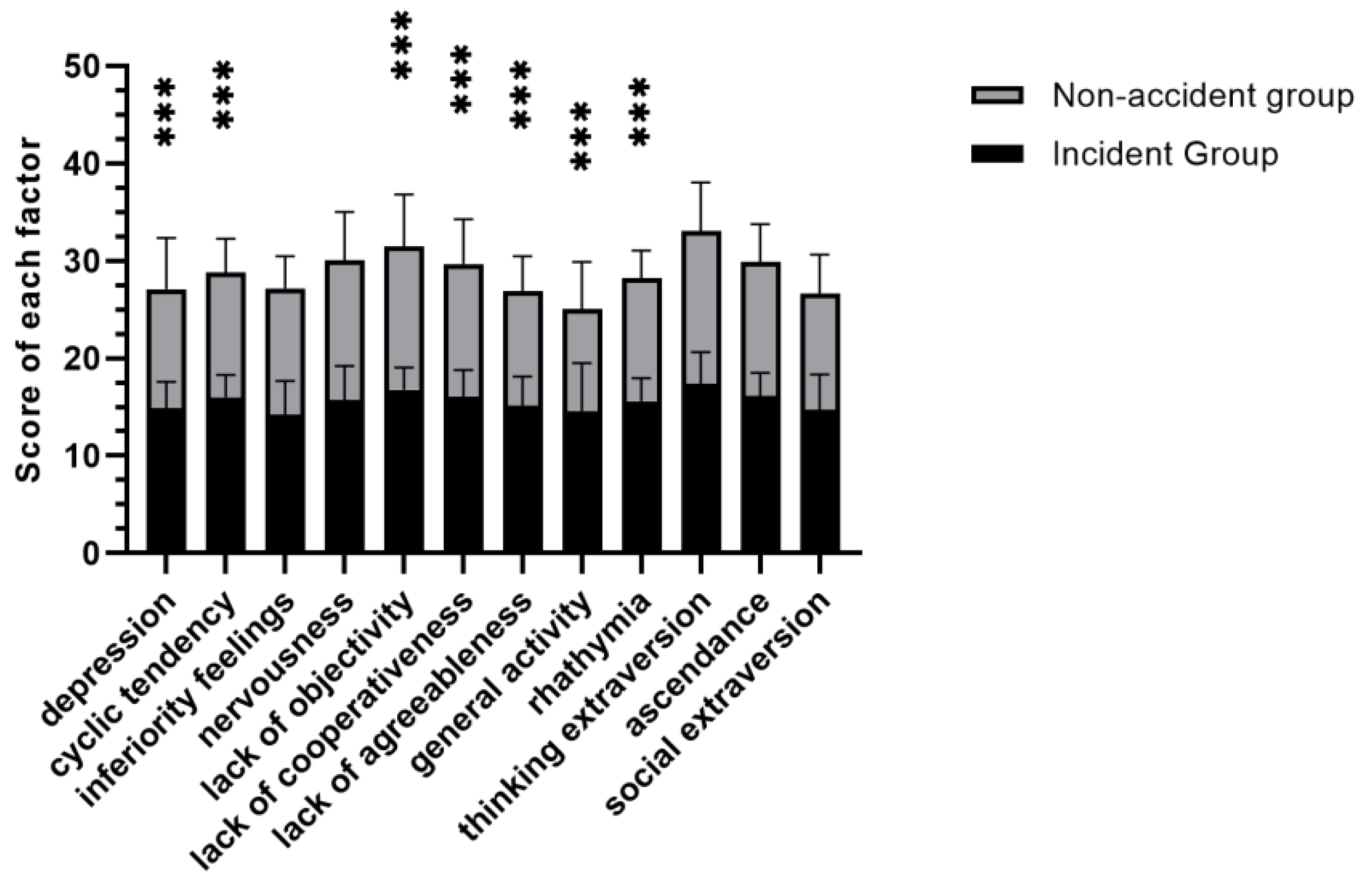
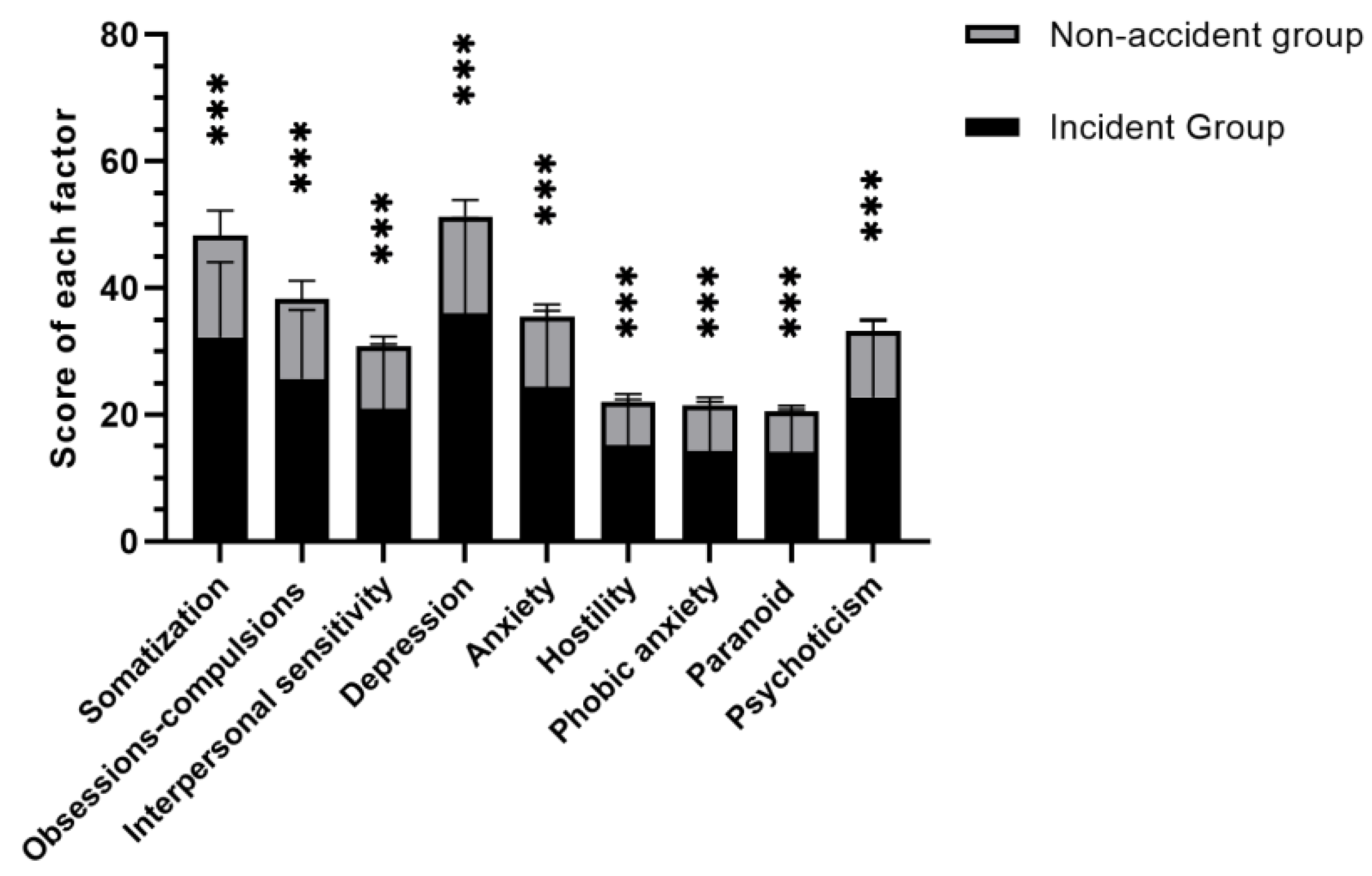

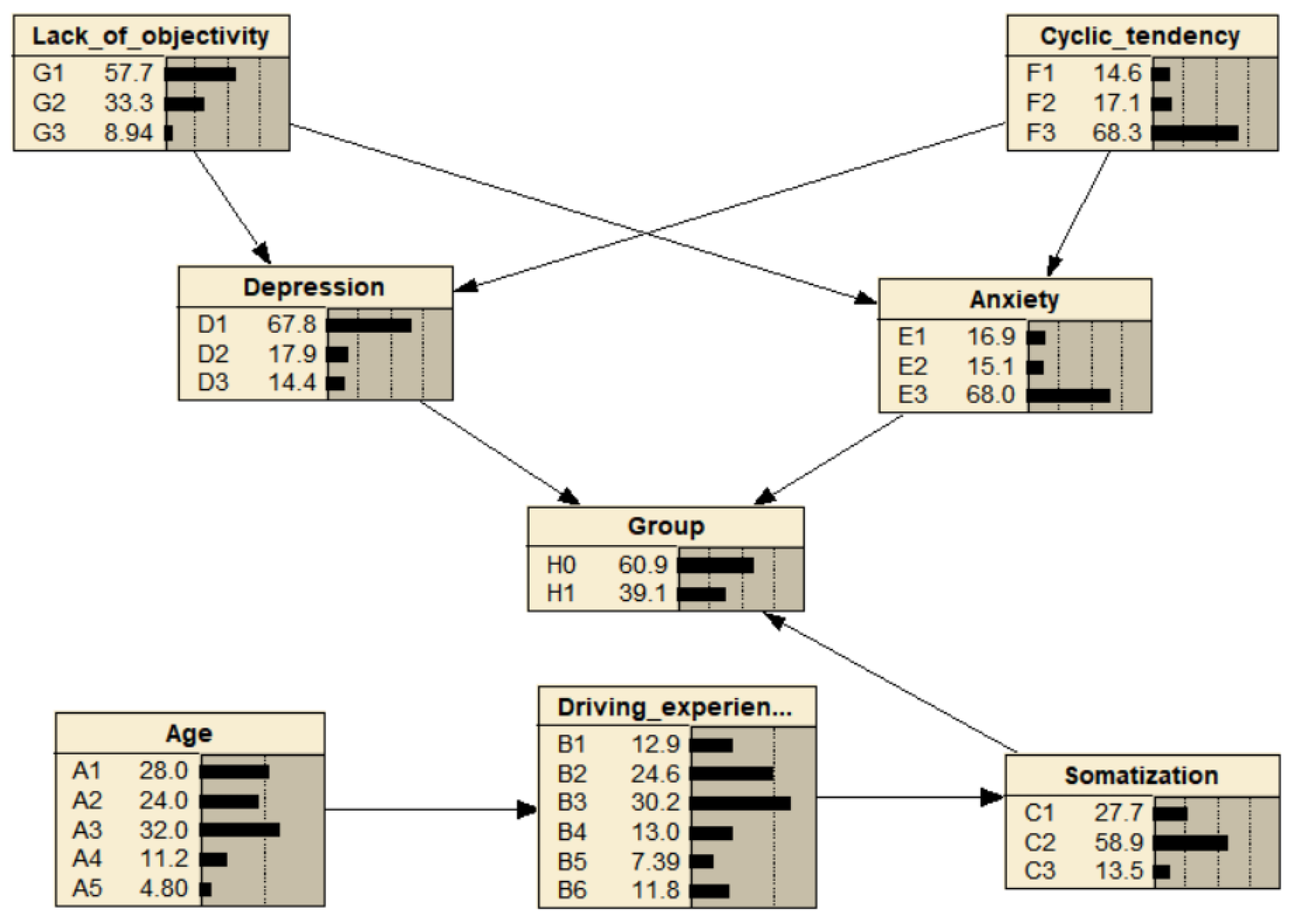
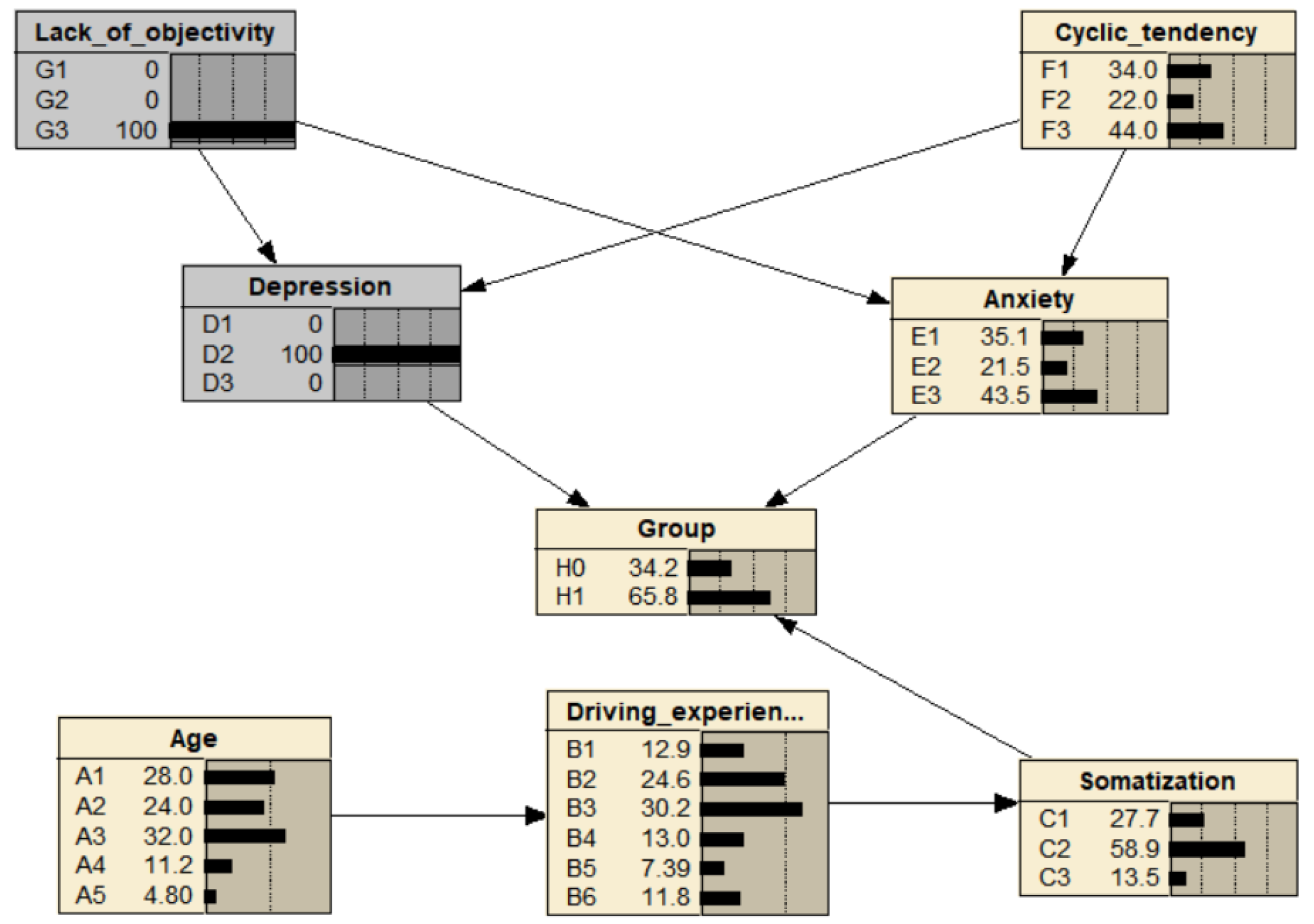
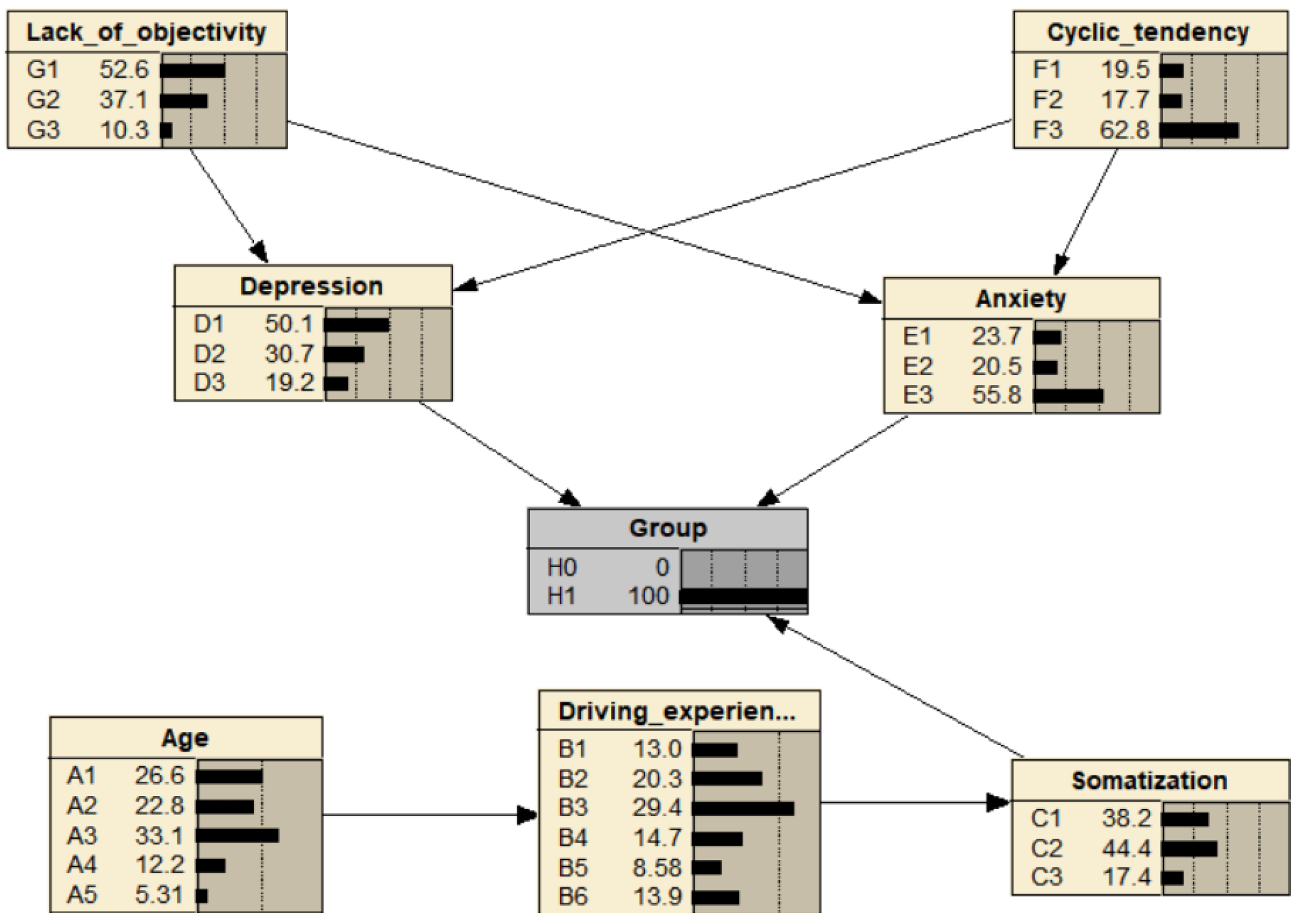
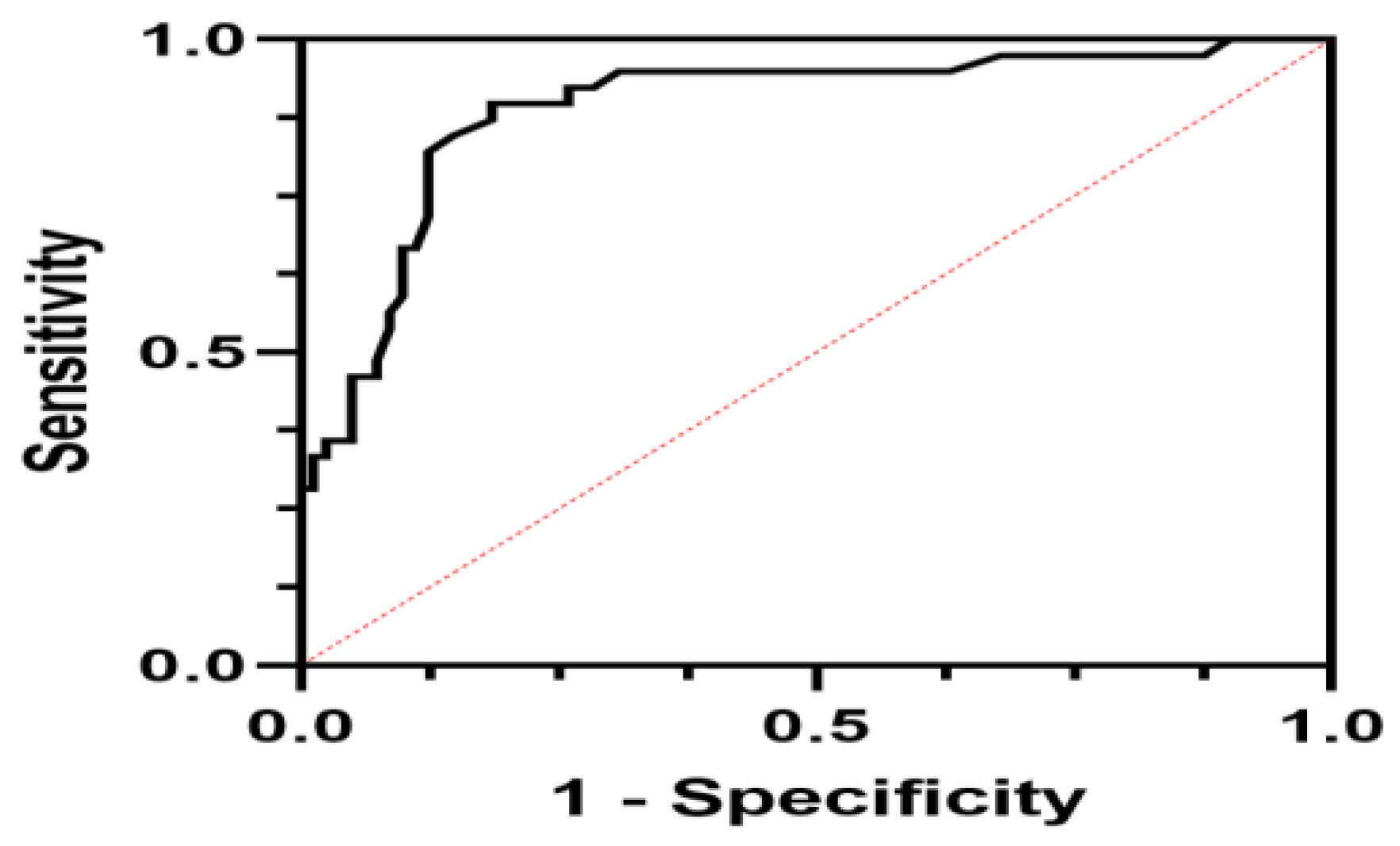
| Demographic Information | Accident Group (n = 40) | Non-Accident Group (n = 80) | p | |||
|---|---|---|---|---|---|---|
| Number of People | Proportion (%) | Number of People | Proportion (%) | |||
| Age | ≤25 years old | 12 | 30 | 7 | 8.8 | 0.005 * |
| 26–35 years old | 9 | 22.5 | 21 | 26.3 | ||
| 36–45 years old | 6 | 15 | 34 | 42.5 | ||
| 46–55 years old | 6 | 15 | 9 | 11.3 | ||
| >55 years old | 7 | 17.5 | 9 | 11.3 | ||
| Driving experience | ≤2 years | 13 | 32.5 | 8 | 10 | 0.026 * |
| 3–5 years | 7 | 17.5 | 10 | 12.5 | ||
| 6–10 years | 6 | 15 | 22 | 27.5 | ||
| 11–15 years | 4 | 10 | 13 | 16.3 | ||
| 16–20 years | 6 | 15 | 10 | 12.5 | ||
| >21 years | 4 | 10 | 17 | 21.3 | ||
| Marital status | Married | 30 | 75 | 68 | 85 | 0.184 |
| Unmarried | 10 | 25 | 12 | 15 | ||
| Education background | Junior high school and below | 12 | 30 | 14 | 17.5 | 0.860 |
| High school and technical secondary school | 16 | 40 | 54 | 67.5 | ||
| Junior college and above | 12 | 30 | 12 | 15 | ||
| OR | 95% CI | p | |||
|---|---|---|---|---|---|
| Age (reference: ≤ 25 years old) | |||||
| 26–35 | 0.166 | 0.081 | 0.389 | 0.003 * | |
| 36–45 | 0.627 | 0.191 | 2.069 | 0.442 | |
| 46–55 | 0.165 | 0.012 | 2.358 | 0.184 | |
| <55 | 1.038 | 0.299 | 3.612 | 0.478 | |
| Driving experience (reference: >21 years) | |||||
| ≤2 | 2.432 | 0.480 | 6.65 | 0.017 * | |
| 3–5 | 1.244 | 0.377 | 5.585 | 0.649 | |
| 6–10 | 1.812 | 0.187 | 4.237 | 0.290 | |
| 11–15 | 1.080 | 0.158 | 2.345 | 0.322 | |
| 16–20 | 0.608 | 0.258 | 1.359 | 0.628 | |
| Y-G | |||||
| Cyclic tendency | 1.41 | 1.100 | 1.808 | 0.007 * | |
| Lack of objectivity | 1.188 | 1.057 | 1.336 | 0.001 * | |
| SCL-90 | |||||
| Somatization | 2.326 | 1.141 | 4.743 | 0.02 * | |
| Depression | 3.251 | 1.153 | 7.049 | 0.023 * | |
| Anxiety | 1.449 | 1.091 | 1.924 | 0.030 * | |
| Variable Name | Symbol | Variable Value |
|---|---|---|
| Age | A | A1: ≤25 A2: 26–35 A3: 36–45 A4: 46–55 A5: >55 |
| Driving experience | B | B1: ≤2 B2: 3–5 B3: 6–10 B4: 11–15 B5: 16–20 B6: >21 |
| Somatization | C | C1 mild: 12–20 C2 moderate: 21–36 C3 severe: 37–57 |
| Depression | D | D1 mild: 13–23 D2 moderate: 24–42 D3 severe: 43–65 |
| Anxiety | E | E1 mild: 10–15 E2 moderate: 16–30 E3 severe: 31–50 |
| Cyclic tendency | F | F1 mild: 5–10 F2 moderate: 11–16 F3 severe: 17–20 |
| Lack of objectivity, | G | G1 mild: 4–9 G2 moderate: 10–15 G3 severe: 16–20 |
| Group | H | H0: Non-accident group H1: Accident group |
| Node | Mutual info | Percent | Variance of Beliefs |
|---|---|---|---|
| Group | 0.96009 | 100 | 0.2362969 |
| Depression | 0.07657 | 7.98 | 0.0253391 |
| Anxiety | 0.03511 | 3.66 | 0.0116539 |
| Somatization | 0.03344 | 3.48 | 0.0109792 |
| Cyclic tendency | 0.01041 | 1.08 | 0.0034847 |
| Driving experience | 0.00645 | 0.672 | 0.0021072 |
| Lack of objectivity | 0.00565 | 0.589 | 0.0018577 |
| Age | 0.00136 | 0.141 | 0.0004463 |
| Node Status | B2 | C1 | C3 | D2 | D3 | E1 | E2 | F1 | G3 |
|---|---|---|---|---|---|---|---|---|---|
| Probability of the updated accident | 47.1% | 54% | 50.6% | 67.2% | 52.2 | 54.8% | 53.1% | 52.1% | 48.3% |
| Variable quantity in probability | 8.0% | 14.9% | 11.5% | 28.1% | 13.1% | 15.7% | 14.0% | 13.0% | 9.2% |
| Node Status | Probability of the Updated Accident | Variable Quantity in Probability |
|---|---|---|
| B2, D2 | 66% | 26.9% |
| C1, E1 | 69.5% | 30.4% |
| C1, F1 | 62.8 | 23.7 |
| C1, D1 | 77.3% | 38.2% |
| C3, D2 | 65.2% | 26.1% |
| D2, F1 | 64.5% | 25.4% |
| D2, G3 | 65.8% | 26.7% |
| D2, E1 | 65.4% | 26.3% |
| D2, E2 | 60.2% | 21.1% |
Disclaimer/Publisher’s Note: The statements, opinions and data contained in all publications are solely those of the individual author(s) and contributor(s) and not of MDPI and/or the editor(s). MDPI and/or the editor(s) disclaim responsibility for any injury to people or property resulting from any ideas, methods, instructions or products referred to in the content. |
© 2022 by the authors. Licensee MDPI, Basel, Switzerland. This article is an open access article distributed under the terms and conditions of the Creative Commons Attribution (CC BY) license (https://creativecommons.org/licenses/by/4.0/).
Share and Cite
Xi, J.; Wang, P.; Ding, T.; Tian, J.; Li, Z. Mental Health and Safety Assessment Methods of Bus Drivers. Appl. Sci. 2023, 13, 100. https://doi.org/10.3390/app13010100
Xi J, Wang P, Ding T, Tian J, Li Z. Mental Health and Safety Assessment Methods of Bus Drivers. Applied Sciences. 2023; 13(1):100. https://doi.org/10.3390/app13010100
Chicago/Turabian StyleXi, Jianfeng, Ping Wang, Tongqiang Ding, Jian Tian, and Zhiqiang Li. 2023. "Mental Health and Safety Assessment Methods of Bus Drivers" Applied Sciences 13, no. 1: 100. https://doi.org/10.3390/app13010100






